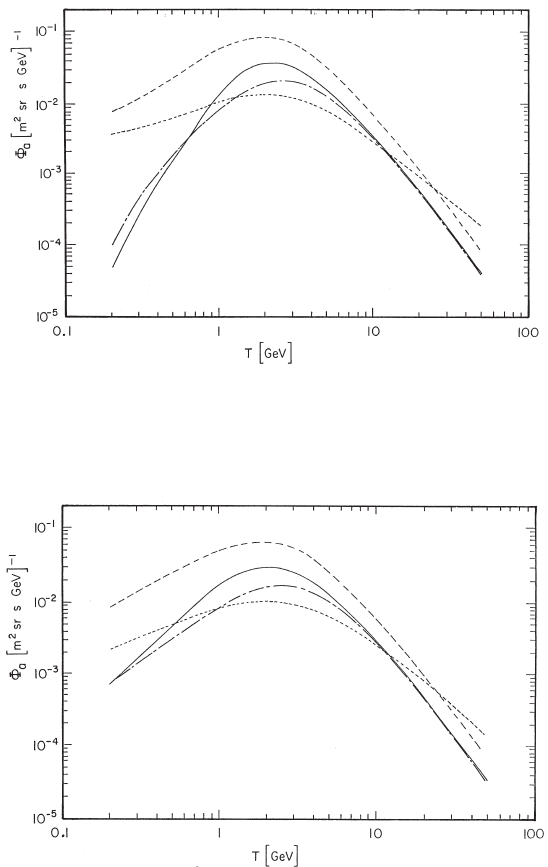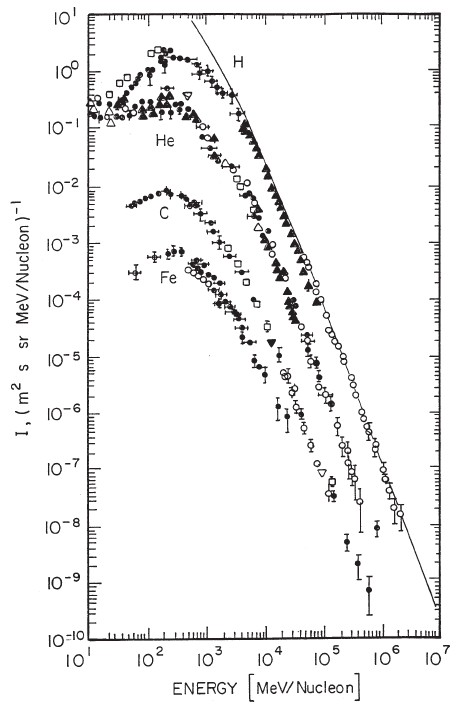Leroy C., Rancoita P.-G. Principles Of Radiation Interaction In Matter And Detection
Подождите немного. Документ загружается.


January 9, 2009 10:21 World Scientific Book - 9.75in x 6.5in ws-bo ok975x65˙n˙2nd˙Ed
710 Principles of Radiation Interaction in Matter and Detection
Fig. 9.35 Estimates (from [Leroy and Rancoita (2000)]) of interstellar antiproton fluxes (Φ
a
)
from production models as a function of the kinetic energy T in GeV: Webber and Potgieter
(dashed line), leaky box [Webber and Potgieter (1989)]; Simon and Heinbach (dotted line), diffusive
reacceleration [Simon and Heinbach (1996)]; Simon and Heinbach (dot-dashed line), leaky box
[Simon and Heinbach (1996)]; Gaisser and Shaefer (solid line), leaky box [Gaisser and Schaefer
(1997)].
Fig. 9.36 Estimates (from [Leroy and Rancoita (2000)]) of effect of the solar modulation as a
function of the kinetic energy T in GeV at minimum activity (Sect. 4.1.2.3) and at the Earth orbit
for the interstellar antiproton fluxes (Φ
a
) shown in Fig. 9.35.
A knee is observed in the spectrum at E ≈ 3 × 10
6
GeV. The knee is
usually attributed to a change in the nature of the propagation of cosmic rays
and/or a decrease in the efficiency of confining particles at very high energies in
the Galaxy [Greisen (1966); Berezinskii, Bulanov, Dogiel, Ginzburg and Ptuskin
January 9, 2009 10:21 World Scientific Book - 9.75in x 6.5in ws-bo ok975x65˙n˙2nd˙Ed
Principles of Particle Energy Determination 711
(1990)]. The particle spectrum presents an ankle between 10
9
and 10
10
GeV. This
ankle is usually interpreted as the result of the injection of a high energy flux of
extragalactic origin [Greisen (1966)].
At low energies, where intensities are high, it is possible to study cosmic rays
through direct measurements via detectors operated in balloons, satellites, space
Shuttles and on board of the International Space Station Alpha. At energies beyond
10
14
eV, the intensities are very low and the study of the cosmic rays is performed
through cascade showers resulting from the degradation of the incident cosmic ray
energy in the atmosphere. The extent of these showers is determined by the size of
the incident particle (electrons, positrons, photons or hadrons) energy. The radiator
volume is now very large since it consists of the whole Earth atmosphere from the
ground level up to about an altitude of 30 km. Since the air shower is spread over a
large area with a low flux of particles, detectors with large collection areas have to
be used. Their array sensitive area cover up to several 10
4
m
2
[Bott-Bodenhausen et
al. (1992)] and effective detection over a volume of up to 100 km
3
[Cassiday (1985)].
9.11.2 Air Showers (AS) and Extensive Air Showers (EAS)
The cosmic rays interact with the terrestrial atmosphere creating air showers
(AS). These interactions produce secondaries through showering processes over long
distances in the atmosphere. If the cosmic ray energy is high enough, the seconda-
ries will reach eventually the ground level where they are detected. The atmosphere,
which acts as a very thick and low density radiator, forces the spread of secondaries
over a large area into so-called extensive air showers (EAS). This spread disperses
the secondaries far enough apart to resolve and count them. In principle, these
secondaries bring information about incident time, direction and energy.
The ratio of extragalactic cosmic rays to local cosmic ray fluxes is thought to be
10
−4
–10
−5
. If the universe were baryon symmetric, about half of the extragalactic
cosmic rays should be antimatter. Fragmentation processes in the galaxy of ori-
gin and modulation in our galaxy will reduce the flux of antimatter. Therefore,
experiments with an antiproton flux sensitivity at the level of (or better than)
10
−3
m
−2
sr
−1
s
−1
GeV
−1
with an antiproton–proton separation capability at the
10
−7
level or better are required to study primordial antimatter.
A component from solar origin is present in primary cosmic rays. Variations in
the magnitude of this component are clearly correlated with solar activity [Berezin-
skii, Bulanov, Dogiel, Ginzburg and Ptuskin (1990)]. As mentioned above, the sig-
nificance of this solar comp onent is small for kinetic energies above 1 GeV and
consequently these particles are not generally catalogued as cosmic rays. Thus, the
main part of the primary cosmic rays reach the Earth’s atmosphere from interstellar
space, produced in our Galaxy with the exception perhaps of particles with ultra
high energies (10
8
–10
10
) GeV which are presumably of extragalactic origin, where
they were accelerated by very large magnetic fields or produced by large size objects
January 9, 2009 10:21 World Scientific Book - 9.75in x 6.5in ws-bo ok975x65˙n˙2nd˙Ed
712 Principles of Radiation Interaction in Matter and Detection
or regions.
There are hadron showers initiated by hadrons, and electromagnetic showers
generated by electrons, positrons and photons. The EAS’s generated by hadrons
develop an electromagnetic component, since an important fraction of the seconda-
ries produced in the process is made of π
0
and η mesons, which decay via electro-
magnetic interaction and generate their own electromagnetic showers (as explained
in Sect. 3.3). Electromagnetic showers or electromagnetic components contain pho-
tons, electrons and positrons. The mechanism of energy loss for these particles is
pair production for photons and bremsstrahlung for electrons and positrons. Thus,
the number of photons, electrons and positrons rapidly increases with the atmo-
sphere depth until the electron and positron energy is down to the critical energy
(²
c
= 81 MeV in air), afterwards which they will lose the remaining energy through
ionization and the number of particles will decrease.
Muons are also involved in the generation of hadron and electromagnetic show-
ers. The charged mesons (π
±
, K
±
) produced in the hadron showers decay into
muons and are responsible for the presence of a large muon component in hadron
initiated showers. This component has a broad distribution since the muons are pro-
duced high in the atmosphere at the start of the hadron shower. Muons can also be
produced in electromagnetic induced showers through the decay of photoproduced
π
±
and K
±
, but less copiously with respect to hadronic induced shower, since
σ(γ-air)/σ(nucleon-air) ≈ 1.4 mb/300 mb. Another source of muons in an electro-
magnetic induced shower is hadroproduction by electrons, but this contributes even
less than photoproduction. Thus, the lateral spread of hadron initiated showers is
much wider than that of electromagnetic showers, especially at low altitude. As was
the case for calorimeters operated with accelerators (Sect. 9.8), a large fraction of
the hadron shower energy (20–30)% goes into nuclear excitation or is carried away
by neutrinos. These observations have consequences for the choice of techniques
used in the study of high energy cosmic rays.
The high energy cascade, produced by the interaction of ultra high energy parti-
cles entering the top of the atmosphere, can be detected by either the observation of
the electromagnetic radiation emitted in the atmosphere by the shower particles via
˘
Cerenkov radiation or visible nitrogen fluorescence, or by the direct observation of
the particles in the cascade. The combination of several techniques of measurement
allows the identification of particles necessary for the search of point sources of high
energy cosmic radiation. The separation between γ’s and hadrons is essential to
this search since γ (like ν), as already stressed, can possibly be traced back to their
sources. In contrast, the sources of charged particles escape retracing since they
reach the Earth surface uniformly after being deflected by the galactic magnetic
field. The γ-hadron separation requires high angular resolution and the possibility
of measuring the muon component in the electromagnetic induced showers.
Air
˘
Cerenkov telescopes are used for the observation of the fast
˘
Cerenkov light
flash emitted by a shower generated in the atmosphere [Weekes (1988)]. The charged

January 9, 2009 10:21 World Scientific Book - 9.75in x 6.5in ws-bo ok975x65˙n˙2nd˙Ed
Principles of Particle Energy Determination 713
Table 9.10 The value of the refractive index,
˘
Cerenkov angle (θ
c
)
and
˘
Cerenkov threshold momenta for electrons [p
c
(e)], pions [p
c
(π)]
and protons [p
c
(p)], as a function of altitude from [Leroy and Ran-
coita (2000)].
Altitude Refractive θ
c
p
c
(e) p
(
π) p
c
(p)
(km) index (degree) (MeV) (GeV) (GeV)
30 1.00000424 0.17 175 48 322
20 1.00001734 0.34 87 24 159
15 1.00003506 0.48 61 17 112
10 1.00007091 0.68 43 12 79
8 1.00009398 0.78 37 10 68
6 1.0001245 0.90 32 9 59
4 1.0001651 1.04 28 8 52
2 1.0002188 1.20 24 7 45
particles traveling at velocities greater than the speed of light in a medium emit
electromagnetic radiation via the
˘
Cerenkov effect (Sects. 2.2.2, 9.5). EAS’s con-
tain relativistic charged particles with momenta above the
˘
Cerenkov threshold. The
˘
Cerenkov angle of the emitted radiation and the
˘
Cerenkov threshold particle veloc-
ity are given by Eqs. (2.132, 2.134), respectively. Since the
˘
Cerenkov effect is related
to the refractive index of the traversed medium, the altitude will be a factor affect-
ing the detection of EAS’s by their
˘
Cerenkov light. At very high altitude i.e., in
the upper layers of the Earth atmosphere, the atmospheric pressure is low and the
refractive index is close to unity. As the altitude decreases, the refractive index
and the
˘
Cerenkov angle increase, while the particle threshold momentum decreases
(Table 9.10).
The observation of
˘
Cerenkov light, produced in the atmosphere by highly rela-
tivistic particles in EAS’s, provides a tool for investigating the longitudinal structure
of the EAS. The intensity of the
˘
Cerenkov light is proportional to the total energy
dissipated in the atmosphere. This method of measurement provides a good angular
resolution. When the shower size is very large, the effective detecting area will be
extended by observing the scintillation light, produced by EAS particles at high
altitudes or the scattering of electromagnetic waves by an ionized column produced
by the EAS. The application of such methods allows the study of EAS’s of very
large size that can be due to primary cosmic rays of energies greater than 10
20
eV.
The main shower development at high altitudes can be observed by its radial
˘
Cerenkov light pattern at the Earth ground level. At high altitudes, the lateral
dispersions of electromagnetic and hadron induced showers are quite different and
the measurement of the
˘
Cerenkov light provides a way to separate photons from
hadrons. The interactions of the charged particles radiating
˘
Cerenkov light with the
atmosphere modify their trajectories and, in particular, the multiple Coulomb scat-
tering spreads the electron paths. The lateral spread of the shower and the fact that
many particles in the shower have a momentum close to the threshold momentum
i) create a situation of overlap for photons generated at different altitudes and ii)
complicates in practice the measurement of the γ/hadron ratio. Therefore, there is a

January 9, 2009 10:21 World Scientific Book - 9.75in x 6.5in ws-bo ok975x65˙n˙2nd˙Ed
714 Principles of Radiation Interaction in Matter and Detection
need to combine
˘
Cerenkov measurements with scintillators or tracking chamber ar-
rays that sample the shower tail, when it reaches the Earth ground level. Significant
progress in the understanding of the cascading mechanisms, γ-hadron separation,
and improved sensitivity in the search for point-like sources or diffuse γ radiation
is expected from the combination of Earth based scintillator and muon detector ar-
rays with a matrix of air
˘
Cerenkov counters recording the shower parameters from
ground level up to the higher layers of the atmosphere [Bott-Bodenhausen et al.
(1992)].
The passage of EAS’s through the atmosphere can also be detected via the mea-
surement of the nitrogen fluorescence light given off by relativistic charged particles
in the shower as performed in the Fly’s Eye detector [Cassiday (1985)]. The main
difference between fluorescence and
˘
Cerenkov light lies in the angular distribution
as the
˘
Cerenkov light is distributed along the shower direction while the fluores-
cence light has an isotropic distribution. The distribution of the number of photons
of fluorescence is approximated by [Chiavassa and Ghia (1996)]:
d
2
N
f
dl d Ω
=
y
l
N
e
4π
, (9.88)
where N
e
is the number of electrons in the EAS (see Sect. 9.11.3.1 below) and
y
l
is the fluorescent yield ≈ 4 γ/electron/m. The fact that fluorescence light is
emitted isotropically from the EAS permits experiments such as the Fly’s Eye de-
tector [Cassiday (1985)] to detect at large distances. The experiments carried out
with this detector include: i) a direct measurement of the proton–air cross section
(at
√
s = 30 TeV), ii) an analysis of the primary cosmic ray spectrum in the energy
range (10
16
–10
20
) eV, iii) an extraction of the composition of the high energy cos-
mic ray primaries, iv) a search for anisotropies in arrival directions, v) a search for
deeply penetrating showers indicative of primary neutrinos, possible heavy-lepton
production and quark matter in the primary flux and, finally, vi) a search for sources
of γ rays near 10
15
eV.
9.11.3 Electromagnetic Air Showers
9.11.3.1 Longitudinal Development
The longitudinal development of the electromagnetic cascades is parameterized as
a function of the age parameter s. For each sub-shower induced by photon (from
π
0
and η decays) or by electrons of energy E, the age s of this sub-shower at depth
t is given by
s =
3t
t + 2y
, (9.89)
where t is the depth measured in radiation length units (∼ 37.0 g/cm
2
in air) and
y = ln (E
0
/²
c
); E
0
is the energy of the primary photon or electron, and ²
c
is the
critical energy (as given in Sect. 2.1.7.4, ²
c
= 81 MeV for air).

January 9, 2009 10:21 World Scientific Book - 9.75in x 6.5in ws-bo ok975x65˙n˙2nd˙Ed
Principles of Particle Energy Determination 715
The age parameter evolves from s = 0 at the point of the first interaction to
s = 1 at the shower maximum, and continues to increase (s > 1) beyond the
shower maximum. The longitudinal development of an electromagnetic cascade can
be described by a parametrization of the number of charged particles (electrons and
positrons), N
e
, in the shower as a function of the depth [Hillas (1982)]:
N
e
(E
0
, E, t) =
0.31
√
y
exp {t[1.0 − 1.5 ln(s)]}. (9.90)
Here E is the threshold energy of electrons. N
e
is often called the size of the
shower. As an example of an application, Eq. (9.90) was used in [Fenyves et al.
(1988)] with a modified form in order to describe the longitudinal development of
the electromagnetic component of EAS’s generated by 10
14
–10
16
eV proton and iron
nuclei:
N
e
f
(E
0
, E, t) = α
p
A(E) N
e
(E
0
, E, t
1
), (9.91)
where α
p
is the number of primary particles (photons or electrons) generating the
shower; A(E) is the fraction of electrons having energies larger than E compared
with the total number of electrons. The modified age parameter, s
1
, is calculated
as a function of the mo dified depth, t
1
, according to:
s
1
=
3t
1
t
1
+ 2y
. (9.92)
The modified depth, t
1
, is given by
t
1
= t + a
π ,γ
(E), (9.93)
where a
π
(E) and a
γ
(E) account for the different development and different t
max
values of electron- and photon-induced showers, resp ectively, with different electron
threshold energies (t
max
is the depth where the shower reaches its maximum). Ex-
amples of values for A(E), a
π
(E) and a
γ
(E) obtained from fits to the data [Fenyves
et al. (1988)] are given in Table 9.11.
9.11.3.2 Lateral Development
The lateral distribution of particles in an electromagnetic shower is usually described
by a parametrization suggested by Nishimura and Kamata (1958):
f(r/R
M
, s, E) = C(s)
µ
r
R
M
¶
s−2
µ
1 −
r
R
M
¶
s−4.5
, (9.94)
Table 9.11 Values of the parameters for the longitu-
dinal and lateral development of electromagnetic air
showers from [Leroy and Rancoita (2000)].
E 5 MeV 10 MeV 15 MeV 20 MeV
A(E) 0.67 0.59 0.52 0.48
a
π
(E) 0.60 0.80 0.92 1.0
a
γ
(E) 0.00 0.20 0.32 0.40
b
π
(E) 0.20 0.40 0.52 0.60
b
γ
(E) -0.40 -0.20 -0.08 0.00

January 9, 2009 10:21 World Scientific Book - 9.75in x 6.5in ws-bo ok975x65˙n˙2nd˙Ed
716 Principles of Radiation Interaction in Matter and Detection
where s is given by Eq. (9.89), E is the threshold energy of the charged particle, r
is the perpendicular distance from the shower axis, and R
M
is the Moli`ere radius
at the level of observation (80 m at sea level and 100 m at 2 km); furthermore, one
imposes the normalization condition [Chiavassa and Ghia (1996)]
2π
Z
∞
0
(r/R
M
)f(r/R
M
, s, E) d(r/R
M
) = 1. (9.95)
The function f(r/R
M
, s, E) represents the probability that a charged particle falls
at a distance r from the shower axis with an area of R
2
M
. It also means that the
factor C(s) is constrained to be:
C(s) =
1
2π
Γ(4.5 − s)
Γ(s) Γ(4.5 − 2s)
. (9.96)
If N
e
is the size of the shower, the charged particle density, ρ
e
, as a function of the
distance r from the shower axis is given by
ρ
e
(r) =
N
e
R
2
M
f(r/R
M
, s, E). (9.97)
Equation (9.94) was applied in [Fenyves et al. (1988)] to the description of the lateral
distribution of the electromagnetic component of an EAS generated by 10
14
–10
16
eV
protons and iron nuclei. Equation (9.94) was modified for the purpose by replacing
R
M
by R
0
M
= 0.5 R
M
. The best fit was obtained for R
0
M
= 45 m at 850 g/cm
2
and
R
0
M
= 37.5 m at sea level. The age parameter was given by
s =
3t
2
t
2
+ 2y
(9.98)
with
t
2
= t + b
π,γ
(E). (9.99)
Here b
π
(E) and b
γ
(E) account for the different development and aging of electron-
and photon-induced showers, respectively, with different electron threshold ener-
gies. Examples of values for b
π
(E) and b
γ
(E) are also given in Table 9.11.
9.11.4 Hadronic Extensive Air Showers
A hadron-induced EAS has a development following closely the steps described
in Sect. 3.3. Basically, the interaction of a incident nucleon with a nucleus in the
upper atmosphere produces many hadrons. Each of these secondary hadrons will
further interact with atmospheric nuclei or decay into other hadrons (π, K), leptons
(e
±
, ν’s) and γ’s. The occurrence of a decay or of an interaction depends on the
atmosphere density. Pions and kaons generated in the upper atmosphere, which also
corresponds to the earlier stage of the shower development, have a higher probability
to decay. In the lower atmosphere, the probability to have an interaction instead
of a decay is significantly higher. The interaction length λ
g, air
[Eq. (3.76)] in air

January 9, 2009 10:21 World Scientific Book - 9.75in x 6.5in ws-bo ok975x65˙n˙2nd˙Ed
Principles of Particle Energy Determination 717
Fig. 9.37 Energy spectra of various nuclei from hydrogen to iron up to energies of hundreds of GeV
per nucleon on the Earth as a function of the kinetic energy per nucleon (from [Simpson (1983)],
reprinted, with permission, from the Annual Review of Nuclear and Particle Science, Volume 33
c
°1983 by Annual Reviews www.annualreviews.org; see also [Leroy and Rancoita (2000)]).
is 80 g/cm
2
. The depth of the atmosphere is commonly put at about 13 λ
g ,air
and
allows for a complete development of the hadronic shower.
As described in Sect. 3.3, there is a multiplication of particles accompanied
with a decrease of the average energy of the secondaries along the shower develop-
ment. The number of particles in the shower will reach a maximum at a depth, which
depends on the primary energy (E
0
), on the type of primary particle, and on the
history of interaction of secondary particles. The interaction of a nucleus with the
atmosphere can be viewed as the interaction of A independent nucleons each with
the energy E
0
/A. The interaction length of a nucleus in the atmosphere is somewhat

January 9, 2009 10:21 World Scientific Book - 9.75in x 6.5in ws-bo ok975x65˙n˙2nd˙Ed
718 Principles of Radiation Interaction in Matter and Detection
reduced compared to that of a nucleon and estimated to be a few g/cm
2
. The intera-
ction of a nucleus with the atmosphere can be thought as a superposition of nucleon
interactions with the atmosphere. The propagation of particles through the atmo-
sphere is described by a system of cascade equations, which describe the transport of
particles through the atmosphere, taking into account the particle properties, their
interactions, and the properties of the atmosphere traversed by the particles. Using
the equations from Gaisser’s textbook [Gaisser (1990)], the transport of nucleons in
the atmosphere is described by
dN
E
0
(E, X)
dX
= −
N
E
0
(E, X)
λ
gN (E)
+ I
NN
, (9.100)
where
I
NN
=
Z
∞
E
N
E
0
(E
0
, X)
λ
gN (E
0
)
F
NN
(E, E
0
)
dE
0
E
, (9.101)
and where N
E
0
(E, X) is the nucleon flux at depth X (expressed in g/cm
2
) in the
atmosphere, and E
0
is the primary energy. The nucleon interaction length in air,
λ
gN (E)
in g/cm
2
, is given at the energy E by means of Eq. (3.76) for A = air, i.e.,
λ
gN (E)
≈ λ
g, air
≈ 80 g/cm
2
.
The atmospheric density, ρ, depends on the altitude, as pointed out earlier. The
function
F
NN
(E, E
0
) = E
c
dn
c
(E
c
, E
a
)
dE
c
(9.102)
is the (dimensionless) inclusive cross section, integrated over transverse momenta,
for an incident nucleon of energy E
0
to collide with an air nucleus and produce an
outgoing nucleon of energy E; dn
c
is the number of particle of type c produced on
average in the energy bin, dE
c
, around E
c
per collision of an incident particle of
type a [Gaisser (1990)].
If one takes into account the secondary pions, Eq. (9.100) has to b e associated
with the following equations [Sokolsky (1989); Gaisser (1990)]:
dΠ
E
0
(E, X)
dx
= −Π
E
0
(E, X)
·
1
λ
gπ
(E)
+
²
π
EX cos θ
¸
+ I
Nπ
c
+ I
π
c
Nπ
c
, (9.103)
where
Z
∞
E
N
E
0
(E
0
, X)
λ
g N (E
0
)
F
Nπ
c
(E, E
0
)
dE
0
E
(9.104)
and
I
π
c
Nπ
c
=
Z
∞
E
Π
E
0
(E
0
, X)
λ
g π(E
0
)
F
π
c
Nπ
c
(E, E
0
)
dE
0
E
, (9.105)
in which Π
E
0
is the average number of pions and λ
g π
(E) is the pion interaction
length in air at the energy E; the term
²
π
EX cos θ

January 9, 2009 10:21 World Scientific Book - 9.75in x 6.5in ws-bo ok975x65˙n˙2nd˙Ed
Principles of Particle Energy Determination 719
accounts for pion decay at the air shower zenith angle θ;
²
π
=
m
π
c
2
h
0
cτ
π
(τ
π
is the pion lifetime) and h
0
varies with the altitude: h
0
= 8400 m at sea level and,
for a vertical atmospheric depth X
v
< 200 g/cm
2
, h
0
= 6400 m [Gaisser (1990)]. π
0
’s
decay (π
0
→ γγ) before they have the chance to interact and, consequently, do
not feed-back the hadronic cascade. The functions F
Nπ
c
and F
π
c
π
c
are defined
analogously to Eq. (9.102) for the processes
N + air → π
c
+ anything
and
π
c
+ air → π
c
+ anything.
The function representing the process
a + air → b + anything
is [Sokolsky (1989)]:
F
ab
(E, E
0
) =
π
σ
inel
Z
E
dσ
ab
d
3
p
dp
2
T
. (9.106)
Applying Feynman scaling [Feynman (1969); Gaisser and Yodh (1980)], F
ab
depends
only on one variable and can b e rewritten as:
F
ab
µ
E
E
0
¶
= F
ab
(X
F
) ,
where
X
F
=
2p
L
√
s
is the Feynman variable. p
L
is the particle momentum component parallel to the
incident particle direction. As a consequence of Feynman scaling hypothesis, the
multiplicity, n, of secondary particles (mostly pions) produced in hadron (nucleon
or π) nucleon collisions depends logarithmically on energy
n = a ln(E). (9.107)
The shower generation is then a process in which a particle almost interacts once
every interaction length, producing a number of secondaries that is roughly constant
per interaction. The maximum of the shower depth increases logarithmically with
E
0
. In the case of Feynman scaling violation, the multiplicity increases faster with
energy, from E
1/4
to E
1/2
. Then, the shower develops faster and earlier in the upper
atmosphere. Indeed, violations of the Feynman scaling are increasingly present as
the energy increases due to the increased hard QCD scattering contribution. As
pointed out in [Battistoni and Grillo (1996)], the scaling hypothesis remains a useful
tool for the understanding of hadronic shower behavior in the atmosphere.
